01 Jan Ancient Celtic Religion: Ancestral Gods and Goddesses
Myths of the Great Goddess teach compassion for all living beings. There you come to appreciate the real sanctity of the earth itself, because it is the body of the Goddess—Joseph Campbell
Introduction
As we continue exploring the mystique of the Ancient Celtic religion, we discover their beliefs have similarities to the Greeks and Hindu Brahmins. The belief in the immortal soul can be tied to the darker Celtic side of keeping enemy heads so they can capture their power. There were 374 names of gods and goddesses recorded throughout the vast area once inhabited by the Celts in Europe, from Ireland to Turkey. Of these names, about 305 of these only occurred once and are thought to be names of local deities particular to each tribe. Only twenty names occur with great frequency in the areas where the Celts once resided and were often associated with the Roman pantheon of deities.
Unfortunately, written accounts by the Celts were sparse. Today, we must rely on Greek and Roman writers, Irish Christian monks, and archaeological artifacts to piece the Ancient Celtic religion together. Classical writers were biased by their perception of Celts being barbarians. Celtic myths written by Christian monks were heavily redacted to reconcile them with the Christian beliefs. Even though the evidence is fragmentary, we can glimpse some of the religious ideas and rituals connected with the pantheon of Celtic deities and their roles by studying the mythology and comparing it to archaeological evidence.
Below is an overview of how the ancient Celts viewed their ancestral god and their belief that the Mother Goddess was involved in the creation of the universe.
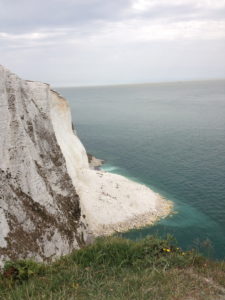
Collapsed Wall of White Cliffs Near Dover 2012
Ancient Celtic Religion
Celtic Ancestral Gods
Caesar and the insular literature indicate the Celts did not look upon their gods as creators but as their ancestors—more as supernatural heroes and heroines. In the lives of these gods and heroes, goddesses, and heroines, the lives of the people, in their emerging patriarchal society and the essence of their religious traditions, were mirrored. The gods and goddesses were depicted as human and were subject to all the natural virtues and vices in an idealized form: love of nature, arts, games, feasts, hunts and heroic single-handed combat. Their intellectual powers were equal to their physical abilities. This depiction of gods as ancestors also appears in Hindu myth and saga.
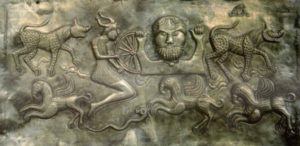
Dagda on the Gundestrup Cup
Pomponius Mela, a Roman historian at the time of Claudius 43 AD, states, “The Druids profess to know the will of the gods.” Hence, the Druids were viewed as the conduits between the moral and immortal world. There is an old Irish passage in which the Druids, like the Hindu Brahmins, boasted they had made the sun, moon, earth and sea. In Vedic mythology (historical predecessor to modern Hinduism), creation began with space (aditi) in which sky and earth were formed and were regarded as the original male and female elements.
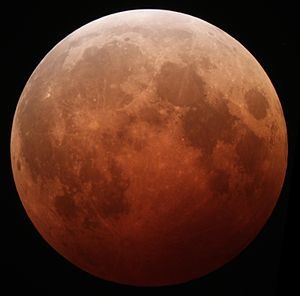
Lunar Eclipse Blood Moon
Mother Goddess
The ancient Celtic bards deemed the river’s edge, the brink of the water, was always that place where wisdom, knowledge and poetry were revealed. The Saône River (Lyon, France) is derived from the Celtic river goddess Souconna, which has also been connected with a local Celtic tribe, the Sequanes.
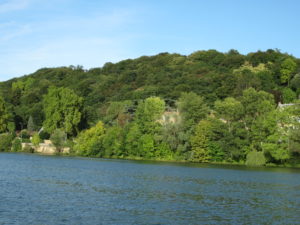
Saône River Lyon France is derived from Gallic river goddess Souconna, which has also been connected with a local Celtic tribe, the Sequanes.
Ancient Celts believed creation evolved around the Mother Goddess. In one tale, the children of the Mother Goddess, Danu, arrive in Ireland to battle the evil Fomorri, whose own Mother Goddess is Domnu. The Irish epic tells of several struggles between the Children of Domnu, representing darkness and evil, and the Children of Danu, representing light and good. Only after the Children of Danu break the powers of the Fomorri at the second Battle of Magh Euireadh did the good gods prevail. Interestingly, the Children of Domnu are never completely overcome or eradicated from the world.
The Children of Danu came from four fabulous cities where named Druids taught them skill, knowledge and perfect wisdom. Further, the Children of Danu brought special treasures from these cities:
- Lia Fáil (Stone of Destiny) from Falias
- Sword from Gorias (the forerunner of the famous Excalibur)
- Spear of victory from Finias
- The Dagda’s cauldron of plenty from Murias
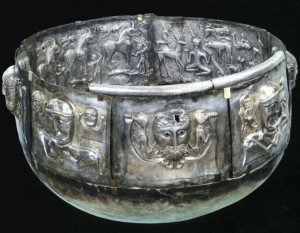
Gundestrup Cauldron
The Dagda is portrayed as the father of the gods in this epic tale. This is significant because The Dagda is Danu’s son by Bilé. As the sacred waters leave from the heavens, Danu waters the oak, Bilé’s male fertility symbol, and gives birth to The Dagda—the good god who fathers the rest of the gods.
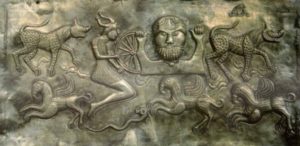
Dagda Portrayed on Gundestrup Cauldron
Bilé is the Old Irish word for a sacred tree which was also used to denote a ‘noble warrior.” Bilé’s role in transporting the souls of the dead Celts to the Otherworld is significant. Transportation is usually via rivers like the Thames or out to the sea. In essence, he transports souls to the divine waters – his consort Danu, the Mother Goddess. Hence, Danu takes precedence as the primary source of life. More will be discussed below about the association of Bilé with Apollo.
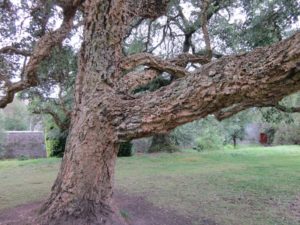
Cork Oak Tree; ‘Druid’ derived from ‘dru-wid’ — “Oak Knowledge”
Overview of Celtic Deities
Celts did not visualize gods with exclusive roles. Not only did their deities have different functions – and therefore were polyvalent— they also appeared in various forms—and thus were polymorphic. Another common feature associated with these deities is votive offerings that were offered at lakes and rivers to win the favor of the gods. Their links with water, trees, and groves suggest the Celts worship earth gods as opposed to the sky gods of the Greeks and Romans.
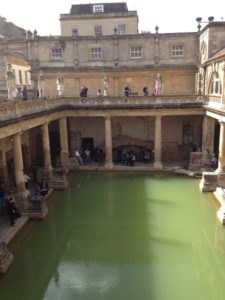
Bath Roman in Bath Britain; Dedicated to Celtic goddess Sulis, whom the Romans identified with Minerva
Julius Caesar associated the Celtic gods in Gaul with Roman deities as follows:
“They [Celts] worship chiefly the god Mercury; of him there are many symbols, and they regard him as the inventor of all the arts, the guide of travelers, and as possessing great influence over bargains and commerce. After him they worship Apollo and Mars, Jupiter and Minerva. About these they hold much the same beliefs as other nations. Apollo heals diseases. Minerva teaches the elements of industry and the arts. Jupiter rules over the heavens and Mars directs war.”
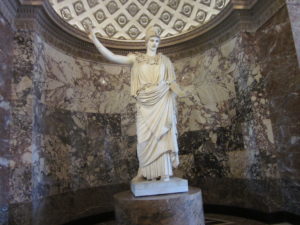
Statue of Roman Goddess, Minerva, is associated with Celtic Goddess, Sulis of Wisdom and Decisions
Caesar also recorded the Celts in Gaul believed they were descended from Dispater, which the Romans associated with the god of the underworld and of the night. The 18th Century French Historian, Henri D’Arbois de Jubainville, identified the Dispater as the Celtic god Bilé (also known as Bel, Belinus and Belenus). His feast day was celebrated on 1 May (Beltane). As discussed above, Bilé appears to be a god of the dead and is portrayed as Danu’s consort.
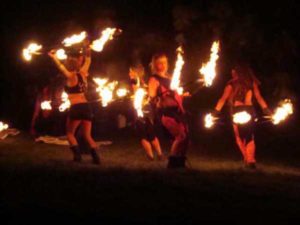
Bonfire During Beltaine Festival Celebrated 1st May
Writing a century after Caesar, the Roman poet Lucan gave particular prominence to the names of three gods: Teutates, Taranis and Esus. Taranis could be equated with Jupiter, as the name survives as toran in Welsh and torann in Irish which are interpreted as meaning thunder. Esus was considered to be equivalent to the god of war Mars.
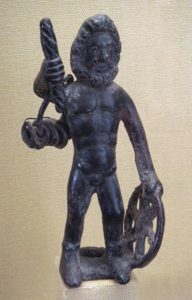
Celtic God Taranus with Wheel and thunderbolt associated with Jupiter
Celtic gods were often depicted with female companions. When patriarchy replaced the “mother goddess” concept, the new male gods had to consort with the old female river goddesses to retain continuity with the old beliefs. A raven, the Celtic symbol of death and battle, perches at their feet. The marriage of a chieftain god with a Mother Goddess was viewed as assuring the people of protection and fertility.

Triple Goddesses
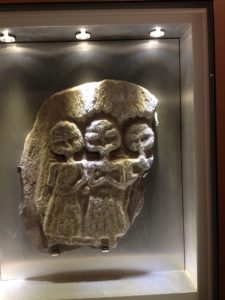
Frieze of Celtic Triplicate Goddesses at Bath, UK
After Christianity achieved dominance in the Celtic world, the ancient gods were relegated to dwell in the hills. In Irish, the word sidhe means mound or hill and denotes the final dwelling places of the Dé Nanaan, the Immortals, after their defeat by the Milesians. The ancient gods, thus driven underground, were relegated in folk memory as the des sidhe, the people of the hills or in later folklore as simply fairies. The most famous fairy is the banshee (bean sidhe), the woman of the fairies whose wail and shriek portends a death. Each god was allotted a sidhe or hill in Ireland by The Dagda before he gave up his leadership of the gods.
Bilé’s Association with Apollo
To judge from inscriptions, the most venerated god was Belenus who can be most closely equated to Apollo. There is evidence of his cult in southern Gaul and northern Italy, and he may have given his name to Beltane, the Irish festival celebrated on the first of May. Worship of him proved to be enduring. Ausonius of Bordeaux, writing in the 4th Century, mentioned a contemporary of his who was a grandson of Phoebicius, a temple priest of Belenus, and whose family bore names associated with the great Apollonian shrine at Delphi.
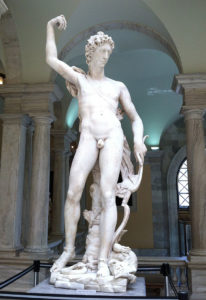
Apollo, God of Sun; Associated with Celtic God Bilé, also known as Bel and Belenus
There are many places named after Bilé throughout Europe. In London, Belenus’ Gate is known as Billingsgate (Bilé’s gate). Presumably the heads of the dead at the original Celtic settlement, and later at the Roman occupied city, were taken though this gate to the river Thames—tamesis, the dark or sluggish river. The human heads were used as votive offerings or simply placed for Bilé to transport them to the Otherworld. Hundreds of skulls from the Celtic period have been discovered in the Thames, around London, with other votive offerings.
As previously discussed in APOLLO’S RAVEN, the ancient Celts believed the soul reposed in the head, not in the region of the heart as Western Christians now have it. That is why the head was so venerated and prized. In one Welsh tale, the mortally wounded Bran the Blessed urges his companions to remove his head and take it back to the Island of the Mighty (Britain) for burial. It takes many years and Bran’s head eats, drinks, and instructs the soldiers on the journey back. The head is buried (legend has it that the site was Tower Hill in London) looking toward France so that, in accordance with Celtic custom, he could protect the land against invasion. Many other examples of talking heads of slain heroes are found in Celtic myth.
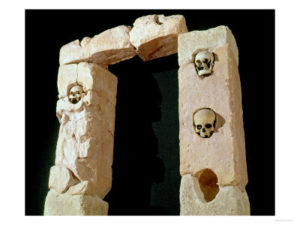
La Roquepertuse Doorway of Skulls
Connecting the many human skulls found in the Thames, together with exquisite swords, shields, helmets and other votive offerings, suggests the Thames could have been a sacred river for the British Celts, occupying the same role as the worship of rivers, springs or wells in Central India.
Bilé was incorporated in many personal Celtic names, the most famous being Cunobeline, who ruled just before the Roman invasion of AD 43. His name means ‘hound of Belinus’. He was later immortalized as the King of Britain in the Shakespearean play entitled, “The Tragedy of Cymbeline.”
To be continued
The next post will provide a more detailed description of the Celtic gods and goddesses.
References
- John Davies, The Celts: Prehistory to Present Day; 2005; Sterling Publishing Co., New York.
- Julius Caesar, translated by F. P. Long, 2005. The Conquest of Gaul; United States: Barnes & Noble, Inc.
- Peter Berresford Ellis, The Druids, 1995; William B. Eerdmans Publishing Co., Grand Rapids, MI.
- Steve Blamires, Magic of the Celtic Otherworld: Irish History, Lore & Rituals, 2009, Llewellyn Publications, Woodbury, MN.
- Joseph Campbell, The Power of Myth with Bill Moyers, 1991; Doubleday, New York, NY.
©copyright January 2017 when first published by Linnea Tanner


rita roberts
Posted at 09:08h, 02 JanuaryAn excellent description of Gods and Goddesses in the ancient world for which I thank you Linnea because you make it much more interesting.
Linnea Tanner
Posted at 03:26h, 03 JanuaryThank you, Rita for your kind comments. The mystique of Celtic mythology and religion has always fascinated me. Have a wonderful New Year?
Linnea
Luciana
Posted at 03:48h, 03 JanuaryHi Linnea,
I really enjoyed reading about the mythology of the Celts. A lot of what you have written reminded me of Sarah Douglass’ Troy Game series which is based on Ancient Briton and the Celts.
I was particularly interested in the Mother Goddess section. The worship of the Mother Goddess was extensive and pre-dates the Bronze era. Perhaps if she wasn’t ousted, the world would be without constant conflict!
Happy 2017, Linnea and I wish you every success in the up coming publication of your book, Apollo’s Raven.
best wishes,
Luciana
Linnea Tanner
Posted at 18:10h, 03 JanuaryHi Luciana,
I appreciate your feedback and will check out Sarah Douglass’ Troy Game series. The ancients’ reverence for the Mother Goddess before the advent of the war gods and human conflict also fascinates me. It is a theme that I particularly found fascinating in your novel, “Search for the Golden Serpent.”
Thank you for your support and best wishes on the upcoming publication of Apollo’s Raven. Wishing you the best on the completion of your next book in the Servant of the Gods Series. Have a wonderful 2017.
Best wishes,
Linnea
afairymind
Posted at 21:55h, 09 JanuaryA fascinating post, Linnea. Women in mythology have been shadowed for too long by the patriarchal reinterpretations of their role. You bring their true natures perfectly into light. I love the Campbell quote you included – that’s something that everyone who wants to write a strong female character ought to keep in mind. 🙂
Linnea Tanner
Posted at 22:17h, 09 JanuaryThank you for your insightful comment. I agree with you that the strengths of women in mythology are often overshadowed by men’s heroic adventures. The meeting of a hero with a goddess often endows him with a “gentle heart,” and deeper meaning of life. This is something we must all consider and understand the balance that everyone brings for greater harmony.
Best wishes,
Linnea